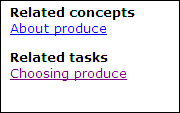Relationship tables
Relationship tables are used to store linking relationships between topics in a collection in the ditamap, rather than in individual topics. Linking relationships are defined in a table-like structure, with rows in the table determining which topics are linked to which.
Automated links based on non-hierarchical relationships are made possible through relationship tables (or reltables).
The coding for a reltable element within a ditamap is similar to that for a table within a topic. It is common for a reltable to have three columns: one for concept topics, one for task topics, and one for reference topics. Relationships between topics of the three information types are specified in the reltable rows.
For example, you may
visualise
the following reltable to associate the concept topic
c.dita (About Produce
) with the task
topic t.dita (Choosing Produce
) and the reference
topic
r.dita (Available Produce
):
| c.dita | t.dita | r.dita |
Such a reltable would generate the following links on the
Available Produce
reference topic:

By manipulating the linking characteristics of the topicref elements in the reltable, you can finely tune the way links are generated.
Relationship tables can technically contain nested topicref elements (that form a hierarchy) within a relcell. However, you should avoid using this sort of construct.